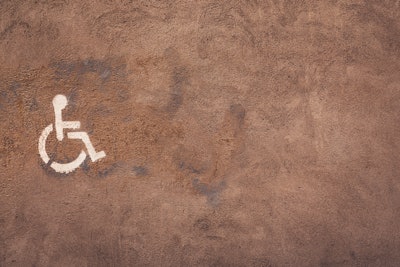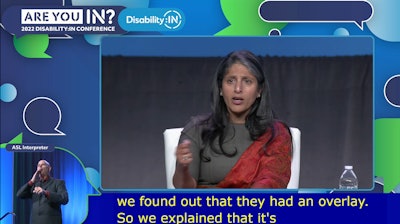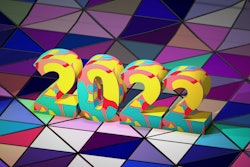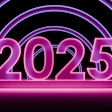
Unfortunately, it’s an industry-old problem where an attendee in a wheelchair shows up to an event without ramps; someone with impaired sight can’t read signage because the planner didn’t think to print it large enough or provide an assisted listening device; or a guest with celiac is left with a rumbling stomach because there were no gluten-free options on the menu. It doesn’t stop there, but you get the idea.
To prevent yourself from being that event prof, BizBash tapped two leaders in the accessibility space: Keely Cat-Wells, an entrepreneur, disability activist, and the founder and president of disabled-led talent management company C Talent @ Whalar, which represents deaf and disabled talent. And Kenny Samsel, the lead producer of edgefactory—the team behind Disability:IN, an annual global conference and expo (the next one is July 10-13, 2023 in Orlando, Fla.).
Here’s what they had to say…
Do know the basics of how accessibility works.
Cat-Wells encourages event profs to be aware that disabilities extend beyond wheelchair access and accessible entrances and exits. However, she notes that “the accessible entrances and exits should not be around the back of the building. Remember—separate is not equal.” Even if a venue is ADA (Americans with Disabilities Act Standards for Accessible Design) compliant, she warns that, at times, the legislation is “the bare minimum.” BizBash tapped Keely Cat-Wells (pictured)—an entrepreneur, disability activist, and the founder and president of disabled-led talent management company C Talent, which represents deaf and disabled talent—to help event profs know the right steps to take for producing an accessible affair.Photo: Courtesy of C Talent
BizBash tapped Keely Cat-Wells (pictured)—an entrepreneur, disability activist, and the founder and president of disabled-led talent management company C Talent, which represents deaf and disabled talent—to help event profs know the right steps to take for producing an accessible affair.Photo: Courtesy of C Talent
She continues: “The same applies with digital spaces. If a disabled person has to go through extra steps to receive entry, it’s not equitable.” In this case, Cat-Wells advises event professionals to “go beyond compliance.”
Samsel adds that event profs must keep in mind that “ASL needs room on camera or in person for the interpreter to move their hands and arms around, and be just as expressive as the main speaker.” Also consider that “international sign (IS) interpreters are 10 times even more expressive and need a lot more space.”
For audio description feeds, Samsel notes that they “should be slightly louder than the main show, but not overbearing," while closed captioning (CC) doesn't have to be black text on a white background. He says that it’s okay to simply have a “darker background with lighter text to make [the text] pop and be easy to read.” Just be sure to “keep CC fonts large, and have no more than three lines on the screen at a time.”
Don’t assume it can’t be done.
Samsel says that accessibility isn’t something that can be written off as something that you don’t have to worry about. “Whether virtual or in person, if there are technical issues that prevent you from, for example, being able to provide a sign language interpreter, it’s still required. It’s still necessary and sometimes legally mandated.”
In this case, Samsel suggests making it work by “having a personal table with a dedicated interpreter [or] possibly a separate virtual feed with a different camera input. Even if the event is for 1,000 people but just one person needs accessible content, you do everything you can to get it done.”
For Cat-Wells, it’s a mindset where access is “integrated from the very beginning.” She adds that doing so will save you money in the long run “while simultaneously creating a more equitable experience”—a win win.
Do understand which accessibility/ies you need to accommodate for.
“It seems simplistic,” Samsel points out, yet it’s still often put at the bottom of a to-do list. “It’s easy to think of CC, but some clients need one or a combination of CC, ASL interpreters, IS interpreters, audio description feed, wheelchair ramps, [or] sensory warnings.”
Not sure what to accommodate for? “Bluntly ask,” Samsel says.
Cat-Wells, meanwhile, has some non-negotiables:
- “Always have quality sign language interpreters and live captioning,” she says, adding that “live captioning should always be done by a human in real-time and not AI.”
- Accessible seating is another one, which she says should “be made available at every price level and seating level—that includes general admission and standing room only.”
- Audio description for those who are blind, visually impaired, or simply “don’t have access to the video stream for the context they need to fully experience the event.”
- A “designated department dedicated to serving disabled guests. This department will help disabled guests that attend your event and ensure their accessibility requirements are fulfilled correctly.”
And once you know what accessibility offerings will be on-site, Cat-Wells advises event marketers to ensure it’s listed on all your marketing materials—which she says to ensure are accessible in and of themselves.
Don’t cut corners.
Although Cat-Wells points out that considering accessibility measures from the get-go is a money-saving move, she advises against choosing low costs over quality. On the same note, she advises event professionals to “add accessibility as a line item in their events budget” to be sure the right measures are taken.
Meanwhile, Samsel points out that planners shouldn’t assume that “those providing the accessible services aren’t in need of accessibility themselves. Many ASL interpreters are themselves deaf and will need CC to assist their interpretations. The accommodations go beyond just the audience.”
On the same note, think about your interpreter’s cues when show-calling cameras, lights, and audio, Samsel says. “Especially when it comes to sign language interpreters, you will need to switch them out every 15-20 minutes so they don’t get tired, so finding natural break points is key.” Kenny Samsel, the lead producer of edgefactory—the event production team behind the Disability:IN conference—encourages event profs to be aware of the accessibilities they'll need to accommodate for. “It’s easy to think of CC, but some clients need one or a combination of CC, ASL interpreters, IS interpreters, audio description feed, wheelchair ramps, [or] sensory warnings," he says.Photo: Courtesy of edgefactory
Kenny Samsel, the lead producer of edgefactory—the event production team behind the Disability:IN conference—encourages event profs to be aware of the accessibilities they'll need to accommodate for. “It’s easy to think of CC, but some clients need one or a combination of CC, ASL interpreters, IS interpreters, audio description feed, wheelchair ramps, [or] sensory warnings," he says.Photo: Courtesy of edgefactory
Do test, test, test.
“Accessibility is often the only way some attendees can experience an event,” Samsel says. So if there aren’t additions to your event’s programming that include options for disabled people, the event could be signed off as a flop by some. But “no different than a camera or the podium microphone … everything should be set up and tested,” Samsel emphasizes.
To take it a step further, consider having disability specialists on your team, so you can “send any videos or pre-recorded, produced items to [them] in advance,” Samsel suggests. “This will definitely help them work through difficult names, specific event or client acronyms or jargon, and overall [improve] understanding of the content to reduce communication errors while live.”
Don’t be intimidated.
Cat-Wells adopts the adage “progress over perfection,” and advises event profs to educate themselves in order to prevent ableism by incorrectly thinking “that disabled people won’t attend certain events, don’t exist within a specific industry, or [that] disability and accessibility ‘look’ a specific way.”
Looking for reads to self-educate? Cat-Wells points to resources like the Social Model of Disability and the Cultural Model of Deafness. She also suggests learning about the meaning of "disability justice" and says event profs are welcome to reach out to the C Talent team for more information.
Samsel suggests “researching and partnering with a service” that provides the services you’re looking for, whether that be CC services or ASL interpreters. “More times than not, they will also have answers or connections if they’re not able to provide it themselves,” he says.



















